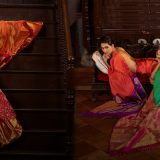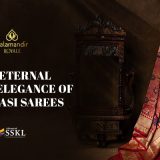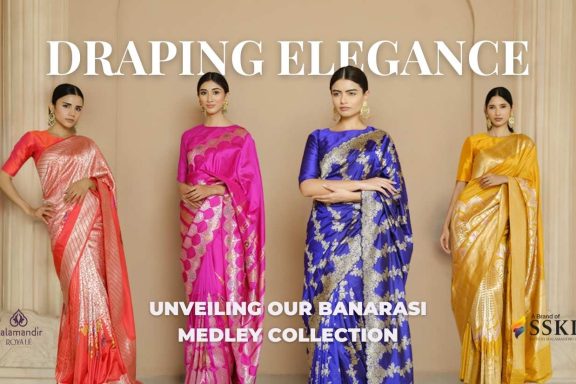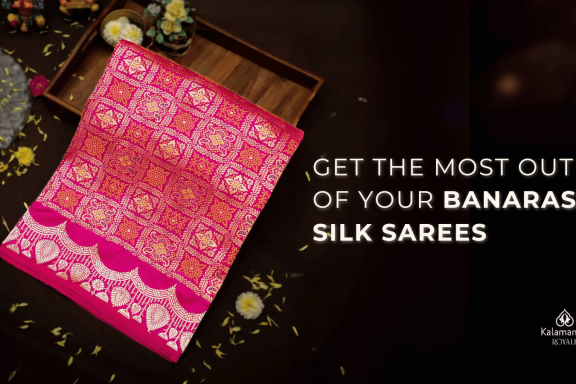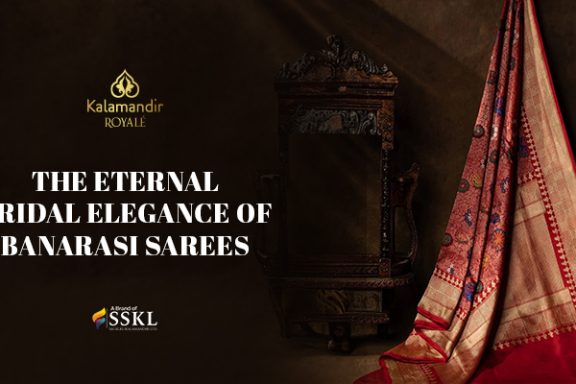Step back in time to the bustling streets of Varanasi, where silk threads shimmer in the golden light of dawn and the aroma of jasmine fills the air. It is here, amongst the ancient temples and winding alleys, that the story of the Banarasi saree begins. These handwoven masterpieces, steeped in tradition and craftsmanship, have been adorning the bodies of Indian women for centuries and continue to symbolise elegance and grace.
Around the 14th century, the artisans from Banaras started to become well-known during the Mughal Empire by producing distinctive and elaborate silk brocades using gold and silver zari threads. The banarasi weaving technique started to become more well-known and sophisticated in the 18th and 19th centuries. The extravagant hand-weaving, superb silk, and gold- and silver-coloured brocade or zari on these sarees, which rank among the best in India, are well-known. Banarasi silk sarees have become more well-known and prominent in the market as a result of the rich designs and expertly woven silk
Features of Banarasi Sarees:
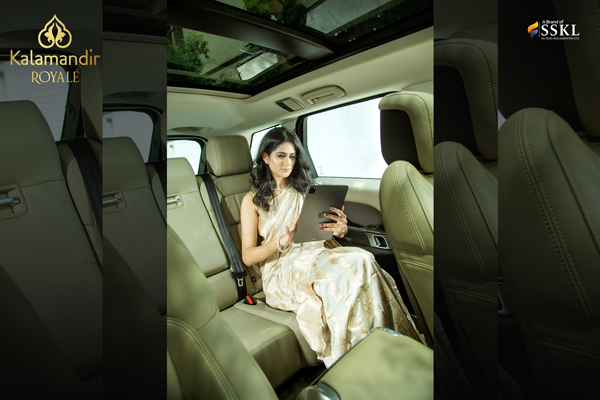
Features of Banarasi Sarees
Banarasi sarees are known for their luxurious silk fabric, intricate zari work, and delicate designs. Some of the key features of these sarees include:
Fabric:
Banarasi sarees are traditionally made from fine silk, often with a gold or silver zari thread woven into the fabric. The silk used for these sarees is known for its softness, shine, and durability.
Zari work:
Metal thread composed of gold or silver is called zari. It is used to decorate the saree with elaborate patterns like paisleys, flowers, and geometric shapes. The complex and delicate zari work on Banarasi sarees is well renowned.
Designs:
The designs on Banarasi sarees are inspired by traditional Indian motifs, such as paisleys, flowers, and geometric patterns. These designs are created using various techniques, including hand embroidery, block printing, and tie dye.
Colours:
Banarasi sarees come in a wide range of colours, but traditional colours include red, maroon, gold, and green.
Border:
The border of a Banarasi saree is usually more comprehensive than other sarees and is adorned with intricate zari work or embroidery.
Pallu:
The Pallu is the part of the saree draping over the shoulder, and it’s usually the most ornate part of the saree. It is decorated with the most intricate zari work or embroidery.
Banarasi sarees are known for their luxurious silk fabric, intricate zari work, and delicate designs. Some of the key features of these sarees include:
Fabric:
Banarasi sarees are traditionally made from fine silk, often with a gold or silver zari thread woven into the fabric. The silk used for these sarees is known for its softness, shine, and durability.
Zari work:
Zari is a type of metallic thread made from gold or silver. It is used to create intricate designs on the saree, such as paisleys, flowers, and geometric patterns. The zari work on Banarasi sarees is known for its intricate and detailed nature.
Designs:
The designs on Banarasi sarees are inspired by traditional Indian motifs, such as paisleys, flowers, and geometric patterns. These designs are created using various techniques, including hand embroidery, block printing, and tie dye.
Colours:
Banarasi sarees come in a wide range of colours, but traditional colours include red, maroon, gold, and green.
Border:
The border of a Banarasi saree is usually wider than other sarees and it is adorned with intricate zari work or embroidery.
Pallu:
The Pallu is the part of the saree draping over the shoulder, and it’s usually the most ornate part of the saree. It is decorated with the most intricate zari work or embroidery.
Heavyweight:
Banarasi sarees are typically quite heavy due to the silk fabric and zari work, making them ideal for special occasions such as weddings and festivals
Making Of Banarasi Sarees:
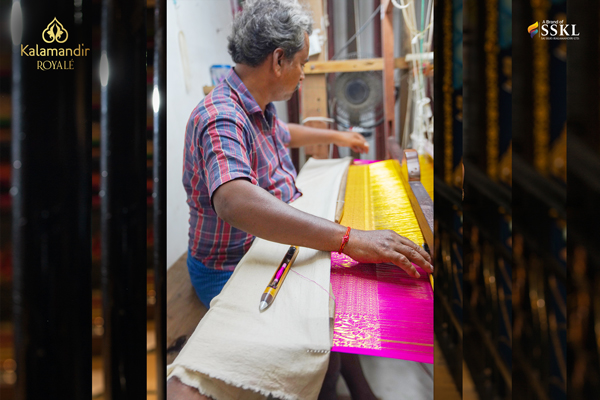
The making of a Banarasi saree is a complex and time-consuming process that involves several steps. Some of the key steps include:
Spinning:
The silk thread used for the sarees is first spun by hand using a spinning wheel. The thread is then dyed and twisted to the desired thickness.
Weaving:
The silk thread is then woven on a handloom to create the base fabric of the saree. The weaver uses a specialized tool called a tana to create the desired pattern.
Zari work:
The zari thread is then added to the saree by a skilled worker. This is done by attaching the zari thread to the silk thread using a specialized needle. The zari work is done on the saree in various patterns such as paisleys, flowers, and geometric patterns.
Embroidery:
Some sarees are adorned with beautiful embroidery, which is done by skilled artisans using a needle and thread.
Finishing:
Once the saree is complete, it is washed and pressed to remove any remaining impurities and give it a smooth finish. The saree is then inspected for quality and any necessary repairs are made before it is ready to be sold
Banarasi Saree Designs:
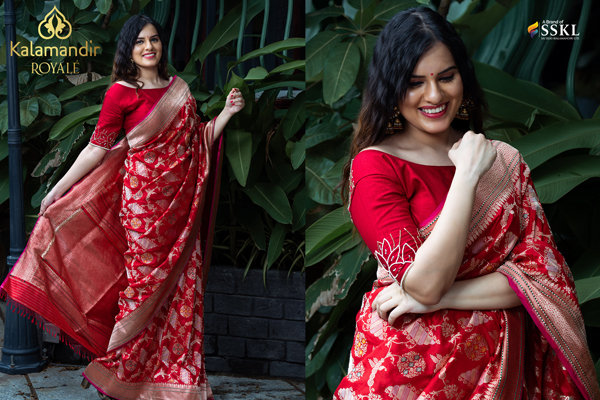
The categories of the Banarasi saree are Tissue, Butidar, Cutwork, Tanchoi, and Jangal. Golden Zari brocade is woven into tissue sarees to give them shine. Self-woven paisleys are used as a pattern on the saree’s borders and pallu. Silver, silk, and gold brocade threads are used in the weaving of butidar sarees. The brocade pattern is known as Ganga-Jumuna because the gold threads are a darker shade of gold than the silver threads. Jamdani sarees are more expensive than cutwork sarees. They are the end result of a cutwork method applied to a basic texture. Cutwork sarees frequently have leaves, jasmine, creepers, and marigold blooms as decorative elements. Weft silk threads in vibrant colours are used to weave the designs on tanchoi saris. Large paisley designs and criss-cross patterns are used as ornaments on this saree. Jangal sarees are made of vibrant silk threads, and they have intricately woven Jangala motifs and natural greenery all over them.
Conclusion:
Banarasi sarees are a symphony of colour and intricate craftsmanship. Each saree tells a story, woven by the skilled hands of artisans who infuse traditional Indian motifs with a contemporary twist. The sarees come alive with the shimmering gold and silver zari work, depicting scenes of nature, mythical creatures and religious symbols. From the delicate paisleys that dance along the border to the bold geometric patterns that adorn the pallu, each design is a true work of art. The sarees are a blend of elegance, tradition and luxury, making them the perfect choice for any special occasion!


